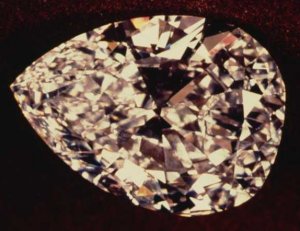Diamond images courtesy of Bob Fixter.
Although diamond is probably the most popular and discussed gemstone, it has probably been in use for a shorter time than any of the other gems that are commonly used in modern times. The reason for this is because lapidaries did not learn to fashion diamond until about the 15th Century when it was discovered that one diamond would abrade another.
India is probably the oldest known source of diamonds but South Africa became the major supplier by the late 19th Century. Historic sources of diamond have also been in Brazil. Review of current literature such as Levinson (1998a, 1998b) show that there have been important diamond finds in California, Colorado, Russia, Australia and Canada.
Diamond is composed of the element Carbon---it crystallized in the isometric system; that is, there are three crystallographic axes that are all of equal length and are perpendicular to one another. In addition to the axial relationships, the crystal can have a center of symmetry, 3 axes of fourfold symmetry, 4 axes of threefold symmetry, 6 axes of twofold symmetry, and 9 planes of symmetry. In a mineralogical text, these symmetry elements would appear as: C, 3A4, 4A3, 6A2, 9P.
An isometric crystal can be defined by numerous forms including a cube (6 faces), an octahedron (8 faces), a dodecahedron (12 faces), a pyritohedron (12 faces), tetrahexahedron (24 faces), a trapezohedron (24 faces) etc. To complicate issues, one form may be superimposed over another such as an octahedron modifying a cube such that the cube appears to have its corners cut off. The superimposition of faces can be quite extreme and an isometric crystal can show several forms superimposed over another. All of these different modifications of the basic isometric crystal can exist within a volume that fills a space occupying one unit by one unit by one unit.
The hardness of diamond is 10 on the Mohs Scale---there is nothing harder. The figure 10 could be said represent the "average" hardness of a diamond. Diamond is not equally hard on all of the theoretical crystal faces that exist in the unit cube above. The dodecahedral faces are just slightly softer than the cube faces or the octahedral faces. If the cube or octahedral faces are 10 hard, then we may think of the dodecahedral faces as being 9.999 hard. It is this fact that makes it possible to shape and polish diamonds. In this figure, the crystal faces marked with d are just a bit softer than the others; those softer faces make diamond shaping and finishing possible.
Diamond crystals have 4 perfect cleavages that are parallel to the octahedral crystal faces. These cleavages are useful to the lapidary as they make it possible to reduce a large, irregular shaped crystal to smaller, more manageable pieces. Apparent planes of cleavage where the stone might break easily are usually selected as separation planes when the crystal is cleaved. The cleavage operation is carried out with a specially shaped chisel and mallet. Many diamonds are now treated with a diamond saw rather than cleaving but the skilled diamond worker still must know the art of cleaving a stone as this is the only some pieces can be handled.
Diamond has a fairly high refractive index: 2.417. That figure measures how much a beam of light is bent and slowed down when it enters the diamond. The high refractive index is what causes the diamond to have its adamantine luster. Diamond has a very high dispersion (0.044), the ability of a substance to break white light down into its component colors. The dispersion is what causes a faceted diamond to show many colors when it is moved about in the light.
Lapidary hobbyists have finished very few diamonds. There are several reasons for this. First is the availability of rough material. Most of the world's diamonds are sold by a monopoly that makes parcels of stones available to cutting houses at sightings that are held only several times a year. The parcels are priced at several millions of dollars each and there is no high grading. The buyer must buy either all or none. In many instances several cutting houses must act together as one to purchase a parcel of diamonds. This effectively eliminates Corner Lapidary Shoppe from the list of potential buyers.
On rare occasions, a piece of suitable rough diamond might reach the hobbyist. The typical faceting unit that is used by the hobbyist or even a commercial colored stone lapidary won't begin to handle a diamond. A small hobby unit will have a 1/30 horsepower to 1/15 Horse Power motor for power. The units used for diamonds have at least a one horsepower motor. The typical hobby unit will have a 6 inch or 8 inch lap whereas the units for diamond will have an 18 inch lap. The shaping and polishing of a diamond generates enough friction that a mechanical dop must be used as dop waxes will melt when diamonds are being fashioned. Neutral oil such as olive oil is usually used to reduce friction in diamond finishing.
Proportions of the finished stone are important to produce the best result. The diagram below shows the ideal proportions for a diamond; these have been determined both experimentally and in practice. If the pavilion is too deep, the center of the stone will appear dark and if is too shallow, the stone will appear washed out.
A diamond appraiser will determine the weight of the properly proportioned stone that can be derived from a finished stone and use that as the weight of appraisal. The cost of refashioning the diamond to a properly proportioned stone is then deducted from the evaluation. This prevents the lapidary from inflating the price of the stone by inflating the weight.
Diamonds are useful for several geological purposes. Petrologists have thought that the tiny inclusions in diamonds that are commonly called "carbon spots" (but rarely are) and include such minerals as pyrope garnet, olivene, and pyrrhotite are tiny samples of the earth's mantle, that zone that is about 30 miles beneath the earth's crust. Thus, inclusions in diamonds may provide some examples of the mantles makeup. Some geologists have suggested that the distribution of diamonds between continents shows examples of spreading ocean basins and provides strong evidence for plate tectonics.
For Further Reading
- Gubelin, E. J., 1974. Internal world of gemstones: documents from space and time. ABC Editions, Zurich, 234 p.
- Hurlbut, C., 1963. Dana's Manual of Mineralogy, 17th Ed., John Wiley & Sons, New York, 609 p.
- Levinson, A. A., 1998a. (Editor). Diamonds in Gemological Abstracts. Gems and Gemology, v. 34, Spring 1998, p. 70-73.
- _____, 1998b. (Editor). Diamonds in Gemological Abstracts. Gems and Gemology, v. 34, p. 308-310.
- Schumann,W., 1977. Gemstones of the World. Sterling Publishing Company, New York, 256 p.
- Shipley, R. M., 1971. Dictionary of Gems and Gemology. Gemological Institute of America, Los Angeles, CA, 227 p.
- Willis, B., and Willis, R., 1934. Geologic Structures. McGraw-Hill Book Co., New York-London, 544 p.











